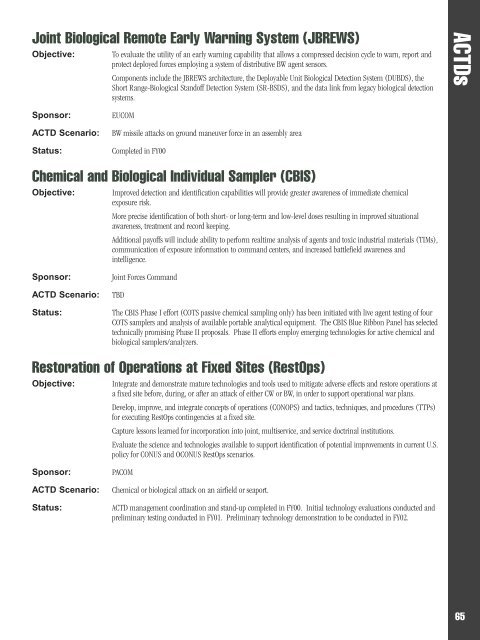Joint Service Chemical & Biological Defense Program Overview ...
Joint Service Chemical & Biological Defense Program Overview ...
Joint Service Chemical & Biological Defense Program Overview ...
Create successful ePaper yourself
Turn your PDF publications into a flip-book with our unique Google optimized e-Paper software.
<strong>Joint</strong> <strong>Biological</strong> Remote Early Warning System (JBREWS)<br />
Objective: To evaluate the utility of an early warning capability that allows a compressed decision cycle to warn, report and<br />
protect deployed forces employing a system of distributive BW agent sensors.<br />
Components include the JBREWS architecture, the Deployable Unit <strong>Biological</strong> Detection System (DUBDS), the<br />
Short Range-<strong>Biological</strong> Standoff Detection System (SR-BSDS), and the data link from legacy biological detection<br />
systems.<br />
Sponsor: EUCOM<br />
ACTD Scenario: BW missile attacks on ground maneuver force in an assembly area<br />
Status: Completed in FY00<br />
<strong>Chemical</strong> and <strong>Biological</strong> Individual Sampler (CBIS)<br />
Objective: Improved detection and identification capabilities will provide greater awareness of immediate chemical<br />
exposure risk.<br />
More precise identification of both short- or long-term and low-level doses resulting in improved situational<br />
awareness, treatment and record keeping.<br />
Additional payoffs will include ability to perform realtime analysis of agents and toxic industrial materials (TIMs),<br />
communication of exposure information to command centers, and increased battlefield awareness and<br />
intelligence.<br />
Sponsor: <strong>Joint</strong> Forces Command<br />
ACTD Scenario: TBD<br />
Status: The CBIS Phase I effort (COTS passive chemical sampling only) has been initiated with live agent testing of four<br />
COTS samplers and analysis of available portable analytical equipment. The CBIS Blue Ribbon Panel has selected<br />
technically promising Phase II proposals. Phase II efforts employ emerging technologies for active chemical and<br />
biological samplers/analyzers.<br />
Restoration of Operations at Fixed Sites (RestOps)<br />
Objective: Integrate and demonstrate mature technologies and tools used to mitigate adverse effects and restore operations at<br />
a fixed site before, during, or after an attack of either CW or BW, in order to support operational war plans.<br />
Develop, improve, and integrate concepts of operations (CONOPS) and tactics, techniques, and procedures (TTPs)<br />
for executing RestOps contingencies at a fixed site.<br />
Capture lessons learned for incorporation into joint, multiservice, and service doctrinal institutions.<br />
Evaluate the science and technologies available to support identification of potential improvements in current U.S.<br />
policy for CONUS and OCONUS RestOps scenarios.<br />
Sponsor: PACOM<br />
ACTD Scenario: <strong>Chemical</strong> or biological attack on an airfield or seaport.<br />
Status: ACTD management coordination and stand-up completed in FY00. Initial technology evaluations conducted and<br />
preliminary testing conducted in FY01. Preliminary technology demonstration to be conducted in FY02.<br />
ACTDs<br />
65
















